Themed collection Nanoscale Horizons and Nanoscale: Nanomaterials for Energy

Recent advances in aggregation-induced emission materials for enhancing solar energy utilization
We summarized the recent progress of aggregation-induced emission (AIE) materials in luminescent solar concentrators, photosynthesis augmentation and solar steam generation. The luminescence and heat generation of AIE materials in different states have been utilized.

Nanoscale Horiz., 2023,8, 453-459
https://doi.org/10.1039/D2NH00506A
Interfacial built-in electric-field for boosting energy conversion electrocatalysis
A critical review of built-in electric fields for the applications in electrocatalytic reactions is organized by focusing on the fundamental concepts, modification strategies, and positive influences on the promotion of catalytic performance.

Nanoscale Horiz., 2023,8, 441-452
https://doi.org/10.1039/D2NH00549B
Self-supported metal–organic framework-based nanostructures as binder-free electrodes for supercapacitors
This minireview highlights the recent progress in the construction of self-supported MOF-based nanostructures including pristine MOFs, MOF composites and MOF derivative arrays, and their application in SCs.
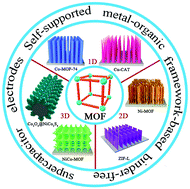
Nanoscale, 2022,14, 2155-2166
https://doi.org/10.1039/D1NR08284A
Photodoping of metal oxide nanocrystals for multi-charge accumulation and light-driven energy storage
Light-driven multi-charge accumulation (i.e., photodoping) of doped metal oxide nanocrystals opens the way to innovative solutions for the direct conversion and storage of the solar energy.
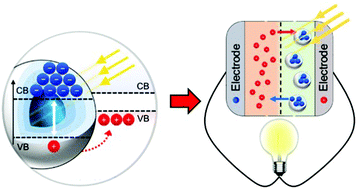
Nanoscale, 2021,13, 8773-8783
https://doi.org/10.1039/D0NR09163D
Recent achievements toward the development of Ni-based layered oxide cathodes for fast-charging Li-ion batteries
This review enhances a fundamental understanding of the degradation mechanisms of Ni-based layered cathodes under fast-charging conditions from atomic to electrode scales. Design strategies for enhancing fast-charging performance are also suggested.

Nanoscale, 2023,15, 4195-4218
https://doi.org/10.1039/D2NR05701H
Revitalizing zinc-ion batteries with advanced zinc anode design
This review focus on the rational design of the highly reversible zinc anode for high-performance aqueous zinc-ion batteries. The design concepts are expected to be applied to other types of high-performance aqueous energy storage systems.

Nanoscale Horiz., 2023,8, 29-54
https://doi.org/10.1039/D2NH00354F
Performance optimization strategies of halide perovskite-based mechanical energy harvesters
In this review, we present the state-of-art progress in halide perovskite-based PENG and TENG devices, focusing on their different performance optimization strategies and prospective applications in the future.
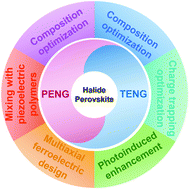
Nanoscale Horiz., 2022,7, 1029-1046
https://doi.org/10.1039/D2NH00229A
Challenges of layer-structured cathodes for sodium-ion batteries
Recent challenges of layer-structured cathodes for sodium-ion batteries and their corresponding structural and compositional modification strategies have been comprehensively studied in this review aiming at high-performance battery technology.

Nanoscale Horiz., 2022,7, 338-351
https://doi.org/10.1039/D1NH00585E
A current overview of the oxidative desulfurization of fuels utilizing heat and solar light: from materials design to catalysis for clean energy
The design strategy and synthesis approach impact the physico-chemical properties, catalytic performances and reaction pathways of ODS catalysts.
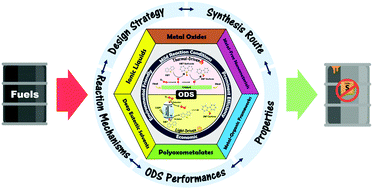
Nanoscale Horiz., 2021,6, 588-633
https://doi.org/10.1039/D1NH00127B
A review of the microwave-assisted synthesis of carbon nanomaterials, metal oxides/hydroxides and their composites for energy storage applications
Microwave-assisted synthesis of carbon nanomaterials, metal oxides/hydroxides and their composites for energy storage applications.

Nanoscale, 2021,13, 11679-11711
https://doi.org/10.1039/D1NR01134K
A review on vertical and lateral heterostructures of semiconducting 2D-MoS2 with other 2D materials: a feasible perspective for energy conversion
Emerging 2D-MoS2 based 2D/2D heterostructures toward high-efficiency energy conversion applications. A powerful combination of 2D-MoS2 with other 2D materials furnishes an excellent heterointerface for superior photo/electrocatalytic performances.
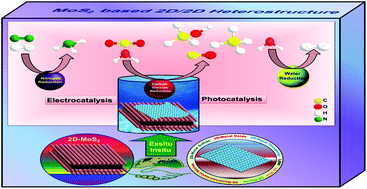
Nanoscale, 2021,13, 9908-9944
https://doi.org/10.1039/D1NR00931A
An interlayer spacing design approach for efficient sodium ion storage in N-doped MoS2
MoS2 in a graphene-like structure that possesses a large interlayer spacing is a promising anode material for sodium ions batteries (SIBs).
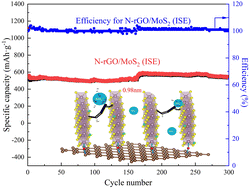
Nanoscale Horiz., 2023,8, 473-482
https://doi.org/10.1039/D2NH00488G
Lithium storage performance and mechanism of nano-sized Ti2InC MAX phase
Nano-sized Ti2InC prepared by ball milling combines the benefits of insertion-type and alloy-type electrodes and thus has a favorable capacity and long cycling life, suggesting that downsized MAX phases would be a promising anode.
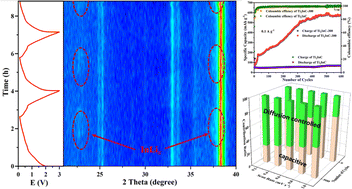
Nanoscale Horiz., 2023,8, 331-337
https://doi.org/10.1039/D2NH00489E
Hydroxide ion-conducting viologen–bakelite organic frameworks for flexible solid-state zinc–air battery applications
A cationic bakelite–viologen polymer with counter-balancing hydroxide ions serves as a solid-state electrolyte for zinc–air battery.
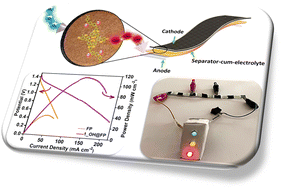
Nanoscale Horiz., 2023,8, 224-234
https://doi.org/10.1039/D2NH00455K
Enhancing magneto-ionic effects in cobalt oxide films by electrolyte engineering
Electrolyte engineering by adding salts to propylene carbonate (PC) leads to enhanced voltage-controlled ON–OFF ferromagnetism via oxygen ion motion in electrolyte-gated Co3O4 films. 35-fold faster magneto-ionic rate is achieved in KI-containing PC.

Nanoscale Horiz., 2023,8, 118-126
https://doi.org/10.1039/D2NH00340F
Microbatteries with twin-Swiss-rolls redefine performance limits in the sub-square millimeter range
Twin Swiss-roll microelectrodes are built up on a chip delivering a high energy density of 458 μW h cm−2, which redefines the performance limit in the sub-0.1 square millimeter range.
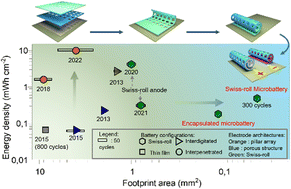
Nanoscale Horiz., 2023,8, 127-132
https://doi.org/10.1039/D2NH00472K
Magnetic-field-controlled counterion migration within polyionic liquid micropores enables nano-energy harvest
The magnetic field is used to separate charges which enables us to fabricate a magnetic energy harvesting device.

Nanoscale Horiz., 2022,7, 1523-1532
https://doi.org/10.1039/D2NH00323F
In situ crafting of a 3D N-doped carbon/defect-rich V2O5−x·nH2O nanosheet composite for high performance fibrous flexible Zn-ion batteries
In situ anodic oxidation strategy is demonstrated to fabricate flexible long-life and high-capacity aqueous zinc-ion batteries adopting a 3D N-doped/defect-rich V2O5−x·nH2O nanosheets as fibrous cathodes and Zn nanosheets arrays as the anode.

Nanoscale Horiz., 2022,7, 1501-1512
https://doi.org/10.1039/D2NH00349J
A sodiophilic VN interlayer stabilizing a Na metal anode
A high-performance Na anode is designed by introducing an artificial VN interlayer (high sodiophilicity) on the Na metal surface (Na/VN) by a simple mechanical rolling process to regulate Na nucleation/deposition behaviors.
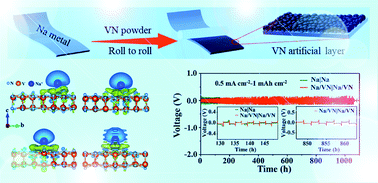
Nanoscale Horiz., 2022,7, 899-907
https://doi.org/10.1039/D2NH00152G
A conductive framework embedded with cobalt-doped vanadium nitride as an efficient polysulfide adsorber and convertor for advanced lithium–sulfur batteries
A conductive framework embedded with cobalt-doped vanadium nitride for enhanced chemisorption and catalytic effects of polysulfides.

Nanoscale Horiz., 2022,7, 543-553
https://doi.org/10.1039/D1NH00512J
Flexible InP–ZnO nanowire heterojunction light emitting diodes
Flexible electronics are gaining rapid popularity in modern day life. We demonstrate a simplified process to make flexible LEDs using p-InP nanowires with conformal coating of ZnO and perform a systematic study.

Nanoscale Horiz., 2022,7, 446-454
https://doi.org/10.1039/D1NH00535A
Deep learning for the automation of particle analysis in catalyst layers for polymer electrolyte fuel cells
This paper presents a deep learning-based approach to automate particle size analysis in the microscopy images of catalyst layers for polymer electrolyte fuel cells.

Nanoscale, 2022,14, 10-18
https://doi.org/10.1039/D1NR06435E
Oxygenated copper vanadium selenide composite nanostructures as a cathode material for zinc-ion batteries with high stability up to 10 000 cycles
The oxygenated copper vanadium selenide composite electrode material as a cathode for aqueous zinc-ion batteries exhibits high capacity with ultra-long cycling life.

Nanoscale, 2023,15, 3978-3990
https://doi.org/10.1039/D2NR06648C
Photo-enhanced lithium-ion batteries using metal–organic frameworks
The development of photo-enhanced lithium-ion batteries, where exposing the electrodes to light results in higher capacities, higher rate performance or self-charging, has recently gained substantial traction. We propose copper-hexahydroxybenzene as the active photo-electrode material which both harvests light and stores energy.

Nanoscale, 2023,15, 4000-4005
https://doi.org/10.1039/D3NR00257H
Two-dimensional cobalt telluride as a piezo-tribogenerator
Utilization of waste heat from laptop/electronic gadgets to generate electricity by using 2D CoTe2 working as a piezo-tribo nanogenerator (PTNG).

Nanoscale, 2022,14, 7788-7797
https://doi.org/10.1039/D2NR00132B
Nanostructured chromium-based broadband absorbers and emitters to realize thermally stable solar thermophotovoltaic systems
The efficiency of traditional solar cells is constrained due to the Shockley–Queisser limit, to circumvent this theoretical limit, the concept of solar thermophotovoltaics (STPVs) has been introduced.
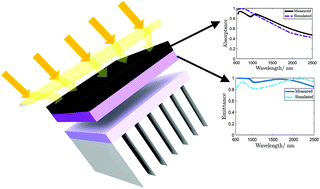
Nanoscale, 2022,14, 6425-6436
https://doi.org/10.1039/D1NR08400C
ZnO and reduced graphene oxide electrodes for all-in-one supercapacitor devices
The nature and positions of defects, i.e., whether they are at the surface or in the lattice, in ZnO and carbonaceous electrodes were identified via EPR spectroscopy. It was shown that defects play a crucial role in supercapacitor device performance.

Nanoscale, 2022,14, 3269-3278
https://doi.org/10.1039/D2NR00018K
Oxygen-induced degradation in AgBiS2 nanocrystal solar cells
The degradation of AgBiS2 nanocrystal solar cells upon exposure to oxygen is strongly impacted by the choice of extraction layers and proceeds via a decomposition of AgBiS2 into Ag2S and Bi2O3.

Nanoscale, 2022,14, 3020-3030
https://doi.org/10.1039/D1NR06456H
An easy to assemble PDMS/CNTs/PANI flexible supercapacitor with high energy-to-power density
PDMS is used as matrix to produce a flexible supercapacitor based on aligned carbon nanotubes and polyaniline, which presents outstanding energy-to-power density ratio and remarkable cycling stability even at different bending angles.
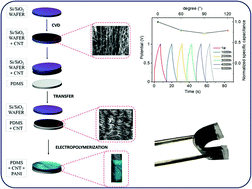
Nanoscale, 2022,14, 2266-2276
https://doi.org/10.1039/D1NR06914D
Enhancement of patterned triboelectric output performance by an interfacial polymer layer for energy harvesting application
To enhance the output performance of line patterned (LP) TENG, a thin layer of PEO and PVA was coated. Among these, the output performance of PEO coated LP TENG was enhanced and found to be 2-fold higher than that of the PVA coated device.
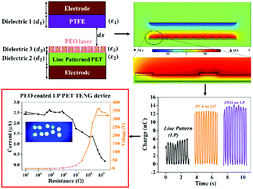
Nanoscale, 2021,13, 20615-20624
https://doi.org/10.1039/D1NR07021E
2D WS2 embedded PVDF nanocomposites for photosensitive piezoelectric nanogenerators with a colossal energy conversion efficiency of ∼25.6%
Benefiting from the advantages of low cost, light weight and mechanical flexibility, piezoelectric nanogenerators have the potential for application in renewable energy harvesting from various unexplored sources.

Nanoscale, 2021,13, 15819-15829
https://doi.org/10.1039/D1NR03808G
ZIF-8 derived hollow carbon to trap polysulfides for high performance lithium–sulfur batteries
The commercial application of Lithium–sulfur batteries (LSBs) is impeded by the shuttle effect. We report zinc (Zn) and nitrogen (N) co-doped ZIF-8 derived hollow carbon (ZHC) as a promising separator coating for LSBs to control the shuttle effect.
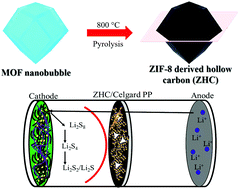
Nanoscale, 2021,13, 11086-11092
https://doi.org/10.1039/D1NR01674A
Charge-storage mechanism of highly defective NiO nanostructures on carbon nanofibers in electrochemical supercapacitors
An electrode composed of defective NiO nanostructures supported on carbon nanofibers and immersed in an Li+-based aqueous electrolyte is studied using Raman spectroscopy under dynamic polarization conditions to address the charge-storage phenomenon.
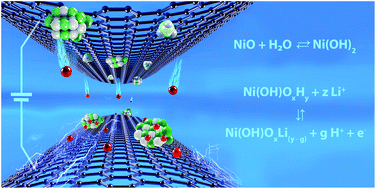
Nanoscale, 2021,13, 9590-9605
https://doi.org/10.1039/D1NR00065A
Co-construction of sulfur vacancies and carbon confinement in V5S8/CNFs to induce an ultra-stable performance for half/full sodium-ion and potassium-ion batteries
Sulfur defective V5S8/CNFs is synthesized by an electrospinning method, followed by sulfuration treatment. The obtained composite exhibits attractive capacities and ultra-stable cycling performances when using as anode materials for sodium-ion and potassium-ion batteries.
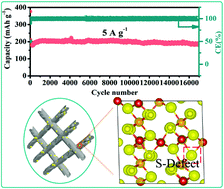
Nanoscale, 2021,13, 5033-5044
https://doi.org/10.1039/D0NR08788B
Carbon nanotubes coupled with layered graphite to support SnTe nanodots as high-rate and ultra-stable lithium-ion battery anodes
SnTe exhibits a layered crystal structure, which enables fast Li-ion diffusion and easy storage, and is considered to be a promising candidate for an advanced anode material.
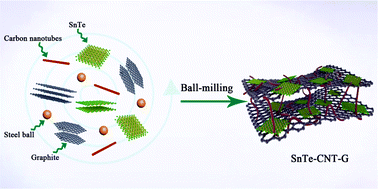
Nanoscale, 2021,13, 3782-3789
https://doi.org/10.1039/D0NR07355E
A high-voltage quasi-solid-state flexible supercapacitor with a wide operational temperature range based on a low-cost “water-in-salt” hydrogel electrolyte
Low-cost and quasi-solid-state polyelectrolyte hydrogel accommodating a superhigh concentration of CH3COOK has been prepared for supercapacitors with high ionic conductivity and electrochemical window.

Nanoscale, 2021,13, 3010-3018
https://doi.org/10.1039/D0NR08437A
A high-energy-density supercapacitor with multi-shelled nickel–manganese selenide hollow spheres as cathode and double-shell nickel–iron selenide hollow spheres as anode electrodes
An effective approach is developed to construct multi-shelled nickel–manganese selenide hollow sphere and double-shell nickel–iron selenide hollow sphere electrode materials for supercapacitors.

Nanoscale, 2021,13, 2931-2945
https://doi.org/10.1039/D0NR08234A
Tuning the electronic structure of layered vanadium pentoxide by pre-intercalation of potassium ions for superior room/low-temperature aqueous zinc-ion batteries
Aqueous zinc-ion batteries (ZIBs), due to their sluggish Zn2+ diffusion kinetics, continue to face challenges in terms of achieving superior high rate, long-term cycling and low-temperature properties.
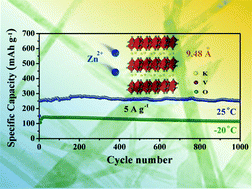
Nanoscale, 2021,13, 2399-2407
https://doi.org/10.1039/D0NR07358J
Natural textile based triboelectric nanogenerators for efficient energy harvesting applications
We reported a facile method to transform surface energy of plain cotton and silk into different tribopolarities. A single natural textile based TENG generated the maximum output voltage of 216.8 V and output current of 50.3 uA.
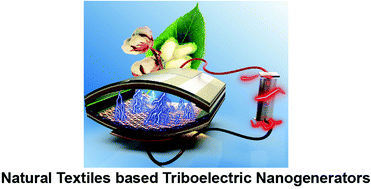
Nanoscale, 2021,13, 2420-2428
https://doi.org/10.1039/D0NR07756A
Highly dispersive Co3O4 nanoparticles incorporated into a cellulose nanofiber for a high-performance flexible supercapacitor
Transition metal oxides used as electrode materials for flexible supercapacitors have attracted huge attention due to their high specific capacitance and surface-to-volume ratio, specifically for cobalt oxide (Co3O4) nanoparticles.

Nanoscale, 2021,13, 355-370
https://doi.org/10.1039/D0NR06982E
About this collection
This online collection from Nanoscale Horizons and Nanoscale showcases some of the recent nanomaterials for energy papers published in the journals.
We hope you enjoy reading these articles!